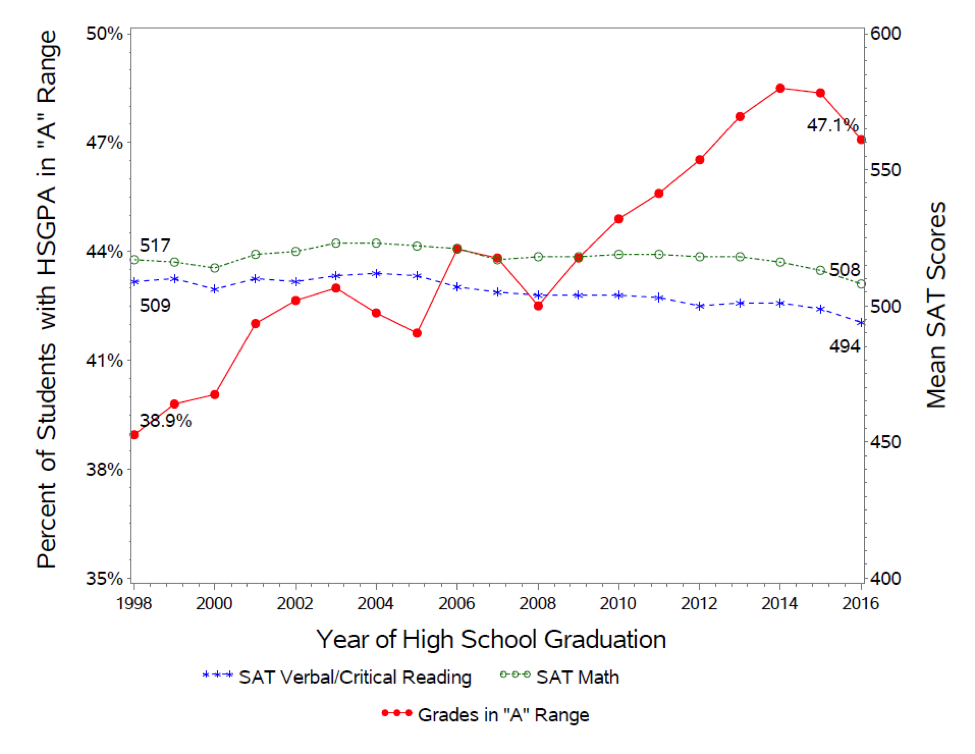The Implications of Grade Inflation for High School Students
Zoe Glasser
As college admissions season approaches, high school seniors are compiling the transcripts and resumes they have been building since ninth grade. With admissions become increasingly competitive, these students are unknowingly being affected by an academic phenomenon 50 years in the making.
Named for the similar concept of monetary inflation, “grade inflation” essentially means that more students than ever are getting As in school, and, consequently, less are failing. In fact, the most popular grade in the United States is A, whereas according to the bell curve model, it should be C.
Grade inflation has two main components: the overall increase in the average number of students receiving high grades, and the overall increase in teachers distributing high grades. The former is a result of increased participation in high-level courses, such as Advanced Placement (AP), Dual Enrollment (DE) and International Baccalaureate (IB), which score on a larger scale than standard and honors classes. The latter is due to a series of regulations which vary by state.
As an effect of the 2001 No Child Left Behind Act, teachers are often evaluated by their students’ performances on standardized tests. This creates a large amount of curriculum-centric work that teachers often grade for completion or effort, resulting in more A grades.
Some speculate that this additional stress is due to colleges wanting to improve their metrics. “[I think] it’s schools trying to make their numbers look better,” said senior Peter Peterson. “It does not seem like the quality of education is improving that much.”
Although many students are not aware of the concept of grade inflation, it impacts their college applications in multiple ways. On one hand, it effectively forces students to find ways to stand out from their peers outside of academia. On the other, it makes building a college resume more difficult because, quite simply, the bar is raised to an almost unattainable level. “It’s good that students are doing well, [but] it is going to get more difficult for students to get into college because grades are going up,” said senior Heidi Vasquez.
Many colleges that once heavily relied on a student’s Grade Point Average (GPA) and transcript as a deciding factor for admission are no longer able to base their acceptance predominantly on grades. Since average grades are on an upward trend, this also means that students find it more difficult to stand out from their peers when applying to college.
Many students must turn to extracurricular activities, including sports and music, as well as leadership positions to bolster their college resumes. The days of admission based solely on strong academic performance are over. “I feel like [grade inflation] is making the college process even harder for people, as it makes almost everyone have equal placement, as they all seem to have the same grade,” said senior Dean Schiller. “So by chance somebody that deserves it may not get into a college, and somebody who was given an A will make it.”
The amount of academic stress that high schoolers are placed under as a result of this increased workload can be harmful to their mental health. “I feel like I should be happy that students are doing well,” said senior Hawa Sharif, “but I also want the competition to be less stressful.”
Sharif is not alone in this; it seems that a large number of T.C. seniors are concerned about their chances of acceptance because of grade inflation. “When it comes to college applications, I constantly worry that I cannot do enough to ensure I am accepted to the colleges I want,” said senior Caroline Simmons. “How can I compete, however perfect my record may be, if everyone else applying is perfect too?”


